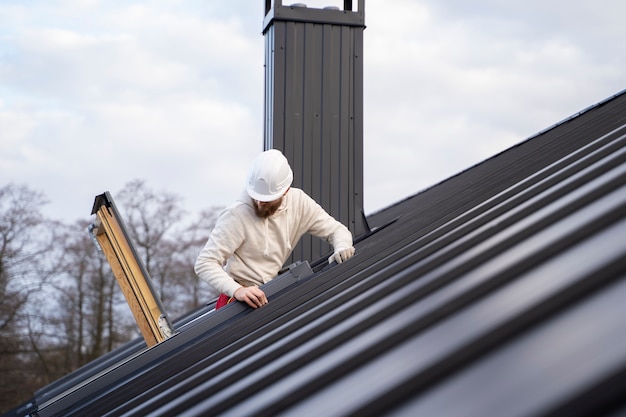
Flat roofs, though popular for their modern aesthetic and practical space utilization, come with their own set of challenges. From drainage issues to leaks, flat roofs require special attention to ensure they remain durable and functional. In this article, we’ll explore some common flat roofing issues and how experienced roofers address them.
Table of Contents
1. Poor Drainage and Ponding Water
Issue: Flat Roof Etobicoke is prone to poor drainage, leading to ponding water. When water accumulates on the roof surface, it can result in structural damage, leaks, and compromised integrity.
Solution: Roofers address this issue by ensuring proper drainage systems are in place. Installing tapered insulation helps create a slope that guides water towards drains. Regular maintenance, including clearing debris from drains and gutters, is crucial to preventing ponding water.
2. Leaking Roof Membrane
Issue: Flat roof membranes, whether built-up roofing (BUR) or single-ply membranes, can develop leaks over time due to wear and tear, punctures, or seam failures.
Solution: Roofers In Etobicoke identify and repair leaks by conducting thorough inspections. Depending on the extent of the damage, they may patch small leaks or recommend a membrane replacement. Regular inspections and prompt repairs are key to preventing extensive water damage.
3. Flashing Failures
Issue: Flashing is essential for preventing water infiltration at roof joints, edges, and penetrations. When flashing fails, it can result in leaks and water damage.
Solution: Roofers address flashing issues by inspecting and repairing or replacing damaged flashing components. Properly installed and maintained flashing is crucial for the longevity of a flat roof, especially in areas prone to heavy rainfall or severe weather.
4. Blistering and Bubbling Membranes
Issue: Flat roof membranes can develop blisters and bubbles over time, compromising their integrity and performance.
Solution: Roofers address blistering by carefully removing the affected membrane sections and repairing or replacing them. Identifying the underlying cause, such as trapped moisture or inadequate adhesion during installation, is essential to prevent future blistering.

5. UV Damage and Deterioration
Issue: Flat roofs are exposed to UV radiation, which can lead to membrane deterioration, cracking, and loss of flexibility over time.
Solution: Roofers address UV damage by recommending and applying reflective coatings or UV-resistant membranes. These measures protect the roof surface from the harmful effects of UV rays, extending the lifespan of the roofing system.
6. Ice Dam Formation
Issue: In colder climates, the accumulation of ice dams on flat roofs can lead to water backup and leaks.
Solution: Roofers address ice dam formation by improving insulation and ventilation to regulate attic temperatures. Additionally, they may recommend the installation of heating cables or using de-icing agents to prevent the formation of ice dams.
7. Inadequate Insulation
Issue: Inadequate insulation in flat roofs can result in energy inefficiency, temperature fluctuations, and increased heating or cooling costs.
Solution: Roofers address inadequate insulation by recommending and installing additional insulation layers. Proper insulation not only improves energy efficiency but also helps prevent issues like condensation within the roofing system.
8. Punctures and Mechanical Damage
Issue: Flat roofs can be susceptible to punctures and mechanical damage from foot traffic, equipment, or debris.
Solution: Roofers address punctures by conducting regular inspections and promptly repairing any damage. Implementing protective measures, such as walkway pads or barriers, can minimize the risk of mechanical damage to the roof membrane.
9. Vegetation Growth and Mold
Issue: Flat roofs can become a breeding ground for vegetation and mold, especially in humid climates.
Solution: Roofers address vegetation growth by implementing proper roof maintenance, including regular cleaning of debris and the application of biocides to prevent mold and algae growth. Keeping the roof surface clean and free of organic matter is crucial for preventing long-term damage.
10. Sagging or Ponding Insulation
Issue: Over time, flat roof insulation may sag or settle, leading to uneven surfaces and potential drainage issues.
Solution: Roofers address sagging insulation by conducting regular inspections and replacing or repositioning insulation panels as needed. Ensuring a level and properly supported insulation layer is essential for maintaining the integrity of the flat roof.
Conclusion
Flat roofs, while stylish and functional, require proactive maintenance to address common issues and ensure their longevity. Experienced roofers play a crucial role in identifying and addressing problems such as poor drainage, leaking membranes, flashing failures, and more. By understanding the unique challenges of flat roofs and implementing preventive measures, roofers help property owners maintain a watertight and durable roofing system. Regular inspections, prompt repairs, and adherence to best practices are key elements in the successful management of flat roofing issues.
